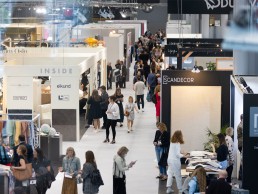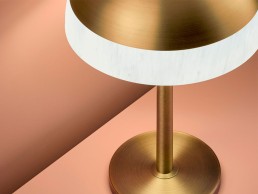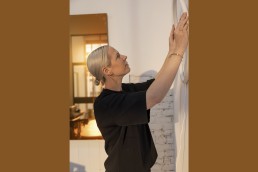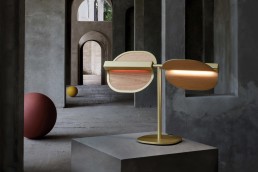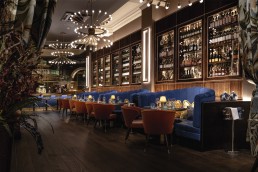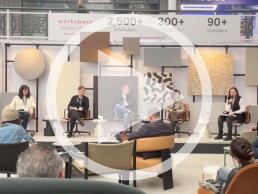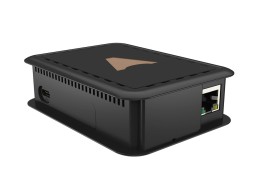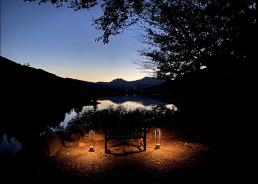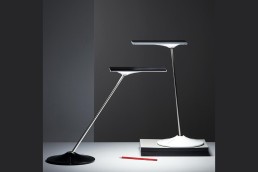ICFF + Wanted Design returns with new highlights
(USA) - Under the direction of co-brand directors, Odile Hainaut and Claire Pijoulat, ICFF + WantedDesign Manhattan returns to the Javits Center May 21-23 with a more cohesive and interactive event, better attendee experiences, and newly designed spaces.
Some of the highlights include:
Designed Spaces:
- NEW: At the Crossroads of American Design: Celebrating the Established and the Emerging. Created by David Rockwell and his firm Rockwell Group and Editor/Co-Curator Pei-Ru Keh, The Crossroads is the new heart and showpiece of the fairs this year. This playful and immersive environment is an ode to two pillars of Americana - the great outdoors and the American home.
- NEW: Welcome Area designed by Moooi
- NEW: Restaurant featuring products from members of Be Original Americas and Mecho Shade
- NEW: WDM Café x Caesarstone with the support of Heller, Fyrn, Tala, Turf, and Mohawk
- Oasis: The location of intimate panel discussions and furnished by Normann Copenhagen, FilzFelt, and Kasthall.
- Wanted Interiors Lounge featuring David Weeks Studio, Kasthall, USM, and Ligne Roset, celebrating the 50th anniversary of the iconic Togo.
ICFF + WantedDesign Manhattan Talks:
The programming for the 2023 Talks includes design leaders and innovators such as Snøhetta, Patricia Urquiola, David Rockwell, Young Huh, Sasha Bikoff, Giulio Cappellini, Jerry Helling, Jamie Derringer, Karim Rashid, Ayse Birsel, Todd Bracher, Mavis Wiggins, and 2022 Designer of the Year Kia Weatherspoon, among many others.
Over the three days, nearly 100 designers, changemakers, and emerging talent will cover topics such as the spirit of American design, the power of mentorship and collaboration across generations, the metaverse and interior design, ethical design, diversity in design, trends that will shape the design industry, ECO Solidarity designers share their insights and work, the Emerging Designer Showcase, Look Book Live, innovation and original design, a conversation with the ICFF Interiors Awards 2023 Designer of the Year and so much more.
Chelsom to launch new collection at CDW
(UK) - Following their 75th anniversary in 2022, the team at Chelsom announce its brand-new collection, Edition 28, which launches on May 23rd 2023 at Clerkenwell Design Week.
The product launch incorporates a complete makeover of its existing lighting collection as well as a brand new website, new sub-brands and an accompanying new catalogue. The new collections are made up of an array of different decorative lighting styles, designed specifically with global hospitality, marine and residential interiors projects in mind.
Designed entirely in-house by Robert and Will Chelsom, the new collections will be on show at Clerkenwell Design Week within an exclusive and private exhibition space. This will be the first time Chelsom has exhibited at this London design event.
Clerkenwell Design Week adds to strong line-up
(UK) – Multidisciplinary artist and designer, Yinka Ilori, is the latest name added to the exciting line-up for Clerkenwell Design Week 2023, joining the likes of Sebastian Cox, and Nipa Doshi of Doshi Levien.
The 12th edition of the festival returns on 23-25 May with its biggest programme yet, featuring a total of more than 600 industry events.
Ilori has teamed up with Domus to launch his debut tile collection – Yinka Ilori x Domus, which will launch at CDW. To mark the occasion, Ilori will present a window display installation demonstrating the creative potential of the new collection. The installation will be on view at Domus Clerkenwell on Great Sutton Street.
Elsewhere, Sebastian Cox is launching his first lounge chair made in British-grown wood and upholstered in entirely natural, sustainable, and non-toxic materials. Nipa Doshi, meanwhile, will close the talks programme, Conversations at Clerkenwell, on 25 May (15.00), speaking to Kaye Preston, Editor of OnOffice, about her recent projects and the significance of colour in design across a client base that varies from furniture and accessories to textiles.
In addition to some of the best names from the industry, this year’s festival welcomes more than 300 design brands and makers exhibiting across 11 temporary venues and six design destinations.
Together with a network of over 130 local showrooms, they offer architects and specifiers, interior designers and the general public alike the opportunity to experience everything from new furniture and lighting to kitchens and bathrooms, materials and surfaces, decorative accessories, and more.
A range of decorative lighting products will be on show in a dedicated exhibition located within the subterranean House of Detention, a former Victorian prison. While Spark & Bell will launch a handmade, long bone China shade named Kinvara, Studio Lloyd, a Cape Town-based lighting studio led by designer Ashlee Lloyd, will exhibit at CDW for the first time – with some of its custom-made crochet statement sculptures including Amoeba and Sayari.
Also new to the festival is Pablo, the brainchild of industrial designer Pablo Pardo. The brand will showcase Totem, a new LED lighting system of blown opal glass shades designed around a modular platform – alongside other pieces such as T.O and Bola Lantern.
From Spain, Aromas will present its newly launched ranges, Elma by Jose Fornas and Elli by JF Sevilla; while Bioo, founded by entrepreneur Pablo Vidarte, will introduce its award-winning Bioo Lux, the world’s first lamp that can be switched on and regulated through human contact with a living plant.
Visitors to Light will also find a variety of decorative and architectural lighting designs from the likes of Lladro, Jonathan Coles, Abalon, Tom Kirk, Studio Haran, Franklite and Erco, among others.
Meanwhile, exhibiting in both Light and British Collection, Curiousa will show its new Wave chandelier made up of five hand-formed glass vessels threaded onto beams of light. Chelsom, new to the festival and one of the show sponsors, is set to unveil its brand-new collection, Edition 28, in Old Sessions House – following its 75th anniversary in 2022.
The 12th edition of Clerkenwell Design Week takes place across EC1, London from 23 – 25 May 2023.
Sabine Marcelis & Henrik Most
Sabine Marcelis has launched her latest range of lighting and accessories in a collaboration with Ikea. Varmblixt is a range that features decorative lighting prominently, as well as glassware, tables, rugs and accessories.
Henrik Most, Creative Leader at Ikea, and Dutch designer Sabine Marcelis give darc further insight into the new collection and their collaboration.
Most has been working with Ikea since 2010 but has a rich past in the design world. After completing a master’s in Art in Design from Copenhagen University, he went on to work as a design curator and lecturer in design. He also has experience working as a cultural journalist and theatre dramaturge.
As Creative Leader at Ikea, Most works on the design, development, and collaborations for the brand. “I am inspired by contemporary art and design and connecting with people through new mediums. I have led previous collaborations including the Art Event, the launch of Markerad with the late Virgil Abloh, and the most recent collection with Marimekko, Bastua,” he says.
“I love contemporary art that has a strong link to what’s going on in our world, particularly regarding important cultural and social topics that touch and affect people. I’m curious about art that discusses these questions in an open and interactive manner. Modern design and architecture are major inspirations for me.
“I was inspired by the Ikea brand’s strong social vision, which really wants to make things better and fundamentally improve people’s lives, so that a better life– no matter who they are, where they live, and how they want to live – is attainable.”
Every day is different in Most’s field of work. “It’s a great aspect of working for a dynamic brand like Ikea. My days range between meetings with colleagues, to looking at prototypes for upcoming product launches, and everything in-between,” he explains.
When asked about Ikea’s designer collaborations, Most describes Ikea as a “curious company”. “[Being] open to new ideas and siding with different people in collaborations is a way to learn, develop and make things better for the everyday life at home,” he says. “When we collaborate, it always starts with a topic, something we are curious about, a challenge or a problem we want to solve. Then, we look at who we could explore this with. We expect these collaborations to be a journey of new learnings, sharing knowledge, exploring together and that in the end, we come up with something new and useful, which responds to people’s needs.”
Marcelis first worked with Ikea as part of the Art Event Collection. This event saw Ikea invite five visionaries working across art and design to create works of art that double-up as useful household objects.
“From our initial collaboration, I learned a lot about her style expression and form language,” says Most. “At the same time, we were looking to make some shifts in the lighting range to make products more emotionally in-tune with our spaces. From there, we were inspired to continue working with Sabine to explore the possibilities in creating the Varmblixt collection.
“We have an entire business area at Ikea of Sweden (Global headquarters responsible for design and development) that is responsible for the lighting. Anna Granath, who is the Range and Design Manager for Lighting, was heavily involved alongside her entire team of talented product developers and engineers.”
When Marcelis was first approached by Most to collaborate, her initial response was one of hesitation. “I got a phone call one day from Henrik asking if we can work together on this collection. At first, I was wondering whether this was a good idea. Do I really have something to bring to this kind of project? In the end, the reason I really dove in was because it was such a nice opportunity to broaden the availability of my design,” she explains. “At the end of the day, my limited-edition pieces are very expensive because they take so much time, and the materials and the processes I use. I really wanted to explore what happens on the reverse side of that, in the more mass-production world of Ikea, without losing any of the quality.”
The collection took two years in total to go from design sketches to prototypes, to products on shelves in Ikea stores. For Marcelis, who is known for creating collectable design pieces that are limited edition, unique, and site-specific, this was a new challenge in order to translate that into products that can be placed in multiple homes.
“That was definitely a big thing for me, to create objects - not only lighting - that are really stripped back to the essence and void of any decorative elements. It’s very much about letting the light be the hero of these pieces and using very minimal materials but with maximum effect,” she says. “[They are] items that have my design language or signature on them, but at the same time, they’re anonymous enough that they can be at home in many types of interiors, which have different aesthetics and scales.
“For the lighting pieces, I normally get to work with materials that are very lush with their own characteristics like cast resins and layered glass. But these materials don’t make sense to use in a mass-production. It was clear from the very beginning that these items wouldn’t have the luxury of relying on the lusciousness of the material to carry the object. So, all the lighting is either made from glass or metal.”
Most adds to this: “From a sustainability point of view, it was not solely to rely on the lusciousness of materiality, but to strip everything back to essentials and with a singular gesture to make it gain its desirability.
“Sustainability is a pillar within the democratic design philosophy at Ikea. It is part of looking at the entire value chain to ensure we design to fit an optimised production process from when products are created, shipped and available at the retail touchpoints.”
One of the things Marcelis was really looking forward to was the interpretations of her pieces in peoples’ homes. “It’s going to be very interesting to see how people will apply these designs in their homes. It was really important for me to also empower the customer to be creative with these objects.”
One of the lighting pieces that demonstrates this flexibility in curation is the “doughnut” lamp. Marcelis clarifies that it is inspired by her love of the shape, and not the food. This lamp can be used as both a table and wall light. “It was quite a task to be able to allow it to be both,” she explains. One of the challenges was ensuring the wall mounting system was not visible when it’s sitting on a table.
Speaking of the doughnut, Marcelis explains her love for the round shape further: “I think it’s just such a beautiful, complete shape. It has an interior curve and an exterior curve. It’s also infinite; there’s no beginning and no end. I love that because of this interesting shape you can really highlight different material qualities. For the Ikea collection, I turned one into a bowl. It’s transparent so you can see through into that interior curve, and because it’s sliced in half, it becomes a vessel. At the same time, the same shape is also a light. I really love to highlight the beauty of materials by repeating form language.”
Another piece that highlights the collection’s versatility is the wall mirror, presenting itself as a usable wall accessory and sculptural light. The mirror lamp consists of a single sheet of glass that has been partially mirrored and tinted in a warm copper-like tone. “The light is placed behind it, which creates this depth when looking through the non-tinted, non-reflective element through the light. At the same time, it’s also interacting with its surroundings because of its reflective front. I love that tension of an object that is extremely simple yet has so many layers because of its materiality,” she says.
Duality is an overall important theme that Marcelis worked into the Varmblixt collection. “I think it’s an absolutely wasted opportunity whenever lighting is designed, which is not really beautiful and sculptural when it’s not in use because you’re going have to have it visible in any case,” she explains. “So, when it’s turned off, it should also be as interesting as when it’s turned on. It’s such a nice opportunity to be creative within that.” Referencing the white circular wall light, Marcelis describes it as a “sculptural element that is activated when the light is turned on”.
“Just like the mirror, it also has a single surface but when you look at them, it has the illusion of a folded surface. That’s purely because there is a difference in colour or a gradient in colour happening on it, which is as if there is light shining on it. So, even the illusion of light still activates the flat surface in that sense.”
Most elaborates on Marcelis’ points, adding: “As part of a long-term goal, Ikea is looking to encourage a shift in the perception of lighting as simply functional to lighting as emotional. It is designed to inspire a new interest in how light can transform the look, feel and atmosphere of our homes.
“Lighting in general is a fundamental aspect of the home and for Ikea, we want to continuously design with purpose. Lighting has always been and will continue to be a core part of the Ikea range.”
During the prototyping phase, Marcelis describes herself as being very “strict” on the Ikea team. “I have to give them so much credit,” she reflects. “We kept prototyping and prototyping until those details were up to standard. I think the design process started in February 2021, and it moved very quickly.”
Marcelis had assumed that from her initial presentation of designs to the Ikea team that approximately 20% would be selected. “That’s not at all what happened. The Ikea team accepted all the ideas that I proposed and now what’s available in the stores is 95% of that presentation. There was a lot of great enthusiastic energy to make those products come to life.” Due to the Covid-19 pandemic, a lot of the prototyping journey was completed remotely for Marcelis, with designs and 3D prints being posted back and forth and lots of good communication. Marcelis is, all things considered, “super-proud” of the end results.
“I think all the products are beautiful, with really well-considered details and smart and effortless mounting systems. They’re packaged in a crazy way as well. That’s something I still cannot get my head around. The chandelier, which takes up a significant amount of space when it’s hung on the ceiling, flat packs down into basically the size of two pizza boxes. So, hats off to the packaging team.”
Marcelis’ overall aim for this new collection was for it to be timeless. “I think my worst nightmare would be if looking back at this collection five years from now people think “Oh, that’s so 2022”, or “Let’s get rid of it and re-do the home with something more modern,” she says. “The pieces are super minimalistic, and I hope that these are designs that can fit in a student’s home but continue to work in the home for that same student when they’re an elderly citizen. Maybe the only trend if you will or change of lifestyle [we’ve observed] that we considered [when designing] is the fact that people are spending more time in their home. So, these objects are really there to enhance that experience.”
Trying to answer an impossible question, Marcelis chooses the doughnut lamp as one of her favourites from the Varmblixt collection, as it was one of the most difficult to produce. “It was really tricky to be able to get a nice equal cover of colour that looked great when the piece is not turned on. But when you turn on the light it needs to give a beautiful glow and a good colour. That took a lot of prototyping to get right, so it’s just so satisfying to see it now - I’m so happy that it worked out.
“I cannot wait to see how people incorporate the pieces into their homes. I think that’s going to be the most rewarding part of this whole project. I love it when people tag me if they have a piece in their house. This collection is so open to interpretation.”
For Most, he too is a fan of the doughnut shape, but particularly the green glass bowls. “To put it simply, it is a collection that celebrates art and design,” he says. “My favourite pieces are the signature bowls - I love how the natural light reflects the colours and the overall versatility of the item.
“We’re all excited that Varmblixt has launched and has been embraced by many people, which is a fantastic feeling.”
Wayfinding the Future
John Williams, Founding Director of Manchester-based interior design studio SpaceInvader, discusses the future of hospitality design and the role lighting has to play in it.
For interior designers, lighting is one of our greatest tools, perhaps nowhere more so than in hospitality design, where lighting’s ability to conjure a particular mood, tone or atmosphere is unparalleled. Light, the core element of any artist or photographer’s craft, is certainly one of ours too when it comes to ensuring a scheme has impact, not only when a customer enters a space but also from the outside too, acting as a beacon to draw customers in, aiding wayfinding or serving instantly to establish the personality of a brand or offer.
What are the main trends in hospitality lighting right now? Well, we could talk about micro-trends, such as using layered lighting with three or more types of lighting at once, for example, but we’d rather pull the lens a little further back and focus on some of the challenges we’re facing currently, as well as looking to the future and particularly to the major driver of sustainability.
In the hotel sector, we’re seeing increasing client demand for artful ways to strip back, re-purpose and be imaginative with existing buildings and interior fabric. The result will be that lighting design plays an increased role as a theatrical element in the form of sculptural pieces or installations, with simple and adaptable wall and flooring surface textures playing host to exciting and controllable dramatic lighting, more akin to what we see in event spaces.
The converse major trend is about less, rather than more, and relates to upcycling. Hoteliers, hospitality operators and developers - at the sharp end of ‘selling’ spaces to consumers - are looking to speed up their sustainability credentials and reporting. When it comes to refurbishing an existing space, the onus particularly falls to interior designers, while we in turn look to consultants and suppliers for help. Would it be unfair to say that lighting design and manufacture - beyond the easy win of using LEDs - is one of the disciplines that has responded least to this to date? Flooring manufacturers are definitely the pioneers in our industry, followed by those producing wall coverings and textiles, with both furniture and lighting design lagging behind.
We still want to bring new and bespoke elements to our projects of course, so we’re not talking about the simple, automatic reuse of existing lighting. Could lighting manufacturers instead collect pieces stripped out of old projects and give us more reuse options that way? Or could we alter the lighting temperature and brightness on existing fittings via new control elements that allow for increased flexibility? We’d also like to see much more information supplied on the materials and processes used in manufacturing each fitting, as well as hard pledges on end-of-life recycling.
In terms of energy usage, great advances have been made in daylight-balancing lighting, which emits lower lighting levels near windows and prevents a space from being over-lit, as well as colour temperature control fittings. Cost, however, remains a huge barrier with the latter, with these types of lights one of the first to be value-engineered out of schemes. Could the lighting design industry help make these solutions more cost-effective and also provide research on long-term cost benefits, to help us win the argument on client investment?
As designers, one of our greatest bugbears in hospitality spaces is where the food and atmosphere don’t match. Think of a tapas bar where the lighting is cool and white, for example, instead of warm and rich. A great recent example of a scheme really getting it right in terms of both the type of food/drink being served and a different kind of sustainability - business longevity - is Foodwell/Firefly in Manchester, whose offer transitions from Foodwell - a bright, soft and airy Californian brunch vibe in the daytime - to Firefly, a glamourous cocktail bar, at night. This is achieved mostly through lighting and music, without compromising on two very different atmospheres.
As a studio, we’re also always on the lookout for the cross-fertilisation of ideas across sectors. The shifts in the post-pandemic workplace saw the design of offices moving ahead of the game, certainly in the provision of zonal variety within a single space to accommodate not only different personality types but addressing neurodiversity and age inclusivity too. Lighting is a key element here. We’d like to see more variety of lighting by both interior designers and lighting designers within single hospitality spaces to address different audiences beyond the median or generic.
Integrated lighting and materiality is a really interesting area right now, especially with the possibilities afforded by 3D printing. We recently created a feature wall in a wellness space, for example, which interacts with light settings - particularly the colours of dusk at the end of the day, when the effect is mesmeric. The relationship between light and materiality is another area we’d love some industry help on. When we pull together a palette for a hospitality scheme, we use natural lighting to get the truest colours. Ideally, we’d like to represent exact lighting conditions to show how materials will look in the final space, relative to the proximity and temperature of proposed lighting, especially when we’re creating CGIs. This is very difficult to achieve digitally. It would be amazing to have a physical testing space – perhaps in a showroom location? – where we could test various different material samples under a number of lighting conditions. Is that a realistic request or will we have to await programmable lighting in order to alter and refine lighting on site to achieve true fidelity to our original vision?
When we’re busy with projects, we tend to be too close to the task at hand to do more than select the best lighting currently available. It’s great sometimes to step back and think about future needs too, seeking out possibilities for improvement, evolution and innovation. It’s always a conversation. Let’s continue to talk!
www.spaceinvaderdesign.co.uk
Image: Pip Rustage
A New Leaf
Spanish lighting brand LZF's Omma collection was designed by Eli Gutierrez. She turns LZF's well-known wooden aesthetic into a stylish family of lights inspired by trees and books.
Omma is one of the newest collections from Spanish lighting brand LZF. Inspired by leaves on tree branches and pages in books, the collection consists of two table lamps in single and two-leaf versions, a floor lamp, a wall light and four different pendant configurations.
Designed by Eli Gutierrez, the collection uses LZF’s patented Timberlite process, a very thin layer of wood veneer that creates the leaf shape that seamlessly attaches to the metal branch.
darc speaks with Sandro Tothill Caggiati, Co-Founder and Factory Director, about the inspirations and creative process of the Omma collection; its name derives from an old Frisian term meaning ‘breath’.
“Marivi Calvo, LZF's other Co-Founder and Art Director, often looks to work with external designers because they each look at Timberlite with a different perspective. She is also constantly looking to work with female designers, as we believe they’re a really underrepresented group in general design. You have your stars, of course, but generally, it’s much harder to break through for women,” he explains.
“Eli came from a working background with Patricia Urquiola, whom she’d worked with for eight years, Philip Starck whom she worked with for a couple of years, and Iranian-French architect and designer India Mahdavi.
“Eli’s approach to designing with us was very cool. She took into consideration our work with wood and identified a concept. She linked that wood comes from trees, trees have leaves, and trees make paper for books, which also have page leaves. When you look at Omma, it looks like an open book. So, when you think of Omma, it’s a reflection and chain of thoughts that started with LZF’s relationship with wood.”
The collection’s design journey took longer than planned due to a change in the technical team at LZF during the process. “New people who came into the tech office inherited the work of previous people. And therefore, I think that in that sense, it was unfortunate because it meant that they inherited design, which had already begun and meant that any new ideas were not easy to put in. We had to finish what was started and finish it the way it was started because so much had already happened and so much development had taken place. It was literally picked up at 75% completion.
“The new tech office started at 75%, but rather than that meaning only 25% of the development time was left, the developing time was over 50%. That was because they had to understand why it was designed the way it was. They then had to work out how to finish the designs and fix the issues that were happening with the prototypes without re-designing the whole fixture,” he explains.
It also went through numerous prototype stages, which Caggiati describes as “hell”. “Each leaf, or pair of leaves, needed to be able to move individually from one another in order to change the direction of the light. A rotation mechanism allows you to alter the light direction to one flat beam, or various angles and ceiling projection.”
The team were eager to not wrap the wood veneer around any form or structure, yet it would act as an actual leaf. “To do that, we had to create a sort of ephemeral, light, metallic structure, which resembled Eli’s original concept. Once that happened, we had the open book form, which we needed to stick a light source down the middle of. The obvious choice was a recessed LED fixed into the lamp.
“When you look at the light from below, you can’t see the LED light source. The light comes down through the sheets instead. You get a great quality of light on your surface, but you can’t see exactly where it comes from. It creates a much more agreeable atmosphere. “There’s no diffuser, all you see is the natural wood and a light glowing out of it.”
In order to combat the swivel movements of the lamp heads, which ensured they remained in place but weren’t too difficult to manipulate to discourage users, the team came up with a gear-like mechanism. “If they were too stiff, the leaves wouldn’t move properly, and if they were too loose, they would just flop down again,” says Caggiati. “We developed a wheel with little grooves, like a cog, that a small ball point screw would click into when the shade was turned. The challenging part was figuring out the groove depth, and we underwent three different test types to achieve this. We then had to make sure the production team were fully briefed on how tight to make these components to meet the required tension.”
Timberlite is LZF’s patented process of treating wood that allows them to use it in such thin layers. Caggiati explains a little more about the process, however, cannot divulge the brand’s secrets: “Timberlite is about half a millimetre thick. We buy the raw veneer and then we use the Timberlite process to treat the veneer. It's not a chemical process, so it's very clean; there are no residues. Really, it's more of a process tied to art and graphics rather than industrial. We don't have to spray it or paint it and there are no solvents involved in its manufacturing. So, once it's been treated, it's very stable and you can store it for quite a long time. It also becomes very easy to then cut without cracking. This allows us to cut it on the digital plotter so we can work with many different shapes.
“We have two ways of working Timberlite. Basically, we have the organic way, which are just shades, which are created using the natural veneer making the shapes. And then the metal skeleton is only there to hold the light source in place.
“Then you have what we call hard shades, which are all the shades that have an acrylic or a metallic frame, which is what gives the shape to the lamp. With the Omma, we had this metallic frame, but it had to be very light, and it had to be bendable. When we were planning on how to glue the wood to it, we decided rather than bring the wood right up to the edge of the metal frame and have it nice flush with the metal, we decided to leave it, so the metal gives it a slight frame.
“Normally, we would've made sure the wood sheet came right to the edge, but then you lose the beauty of that metal, which is an aesthetic quality. So, you get the effect of a metal frame, whether you're looking at it from the top side or from the bottom side. It was a new way of glueing or putting wood onto a structure for us in this sense.”
The collection comes in four main metal finishes for the lamp frames: gold, nickel, matte black and ivory white and is suitable for many various environments from hospitality venues to residential spaces, as Caggiati describes: “I think when you have a family like Omma, it makes it open to everything. The wall sconce is below 10 centimetres, which is a rule in the United States in the disabilities act, which states a wall lamp cannot protrude from the wall more than 10 centimetres in a public building. You've got the table and floor versions, which are good for the home. You've got the ceiling versions, which are good for restaurants, bars, and cafes. And then you've also got the Omma line pendant, which is good for offices. As far as decorating your office with a decorative lighting fixture, it works well as there's enough light on your table from the lamp.”
The Cut & Craft, UK
Using influences from the Titanic, The Cut & Craft in Leeds, UK, has been given a new lease of life by Studio Two and Mistry Lighting.
A historically enriched location found in the heart of Leeds city centre in the UK, The Cut & Craft opened in October 2022. The Grade II listed building, formerly known as Collinson’s Café, was famously frequented by Wallace Hartley, the Band Master of the Titanic. Using this unique affiliation, Cut & Craft’s interiors take inspiration from the elegance of the Titanic, incorporating oceanic colours, textures, and metallic qualities.
Completing the interiors for the new venue was Studio Two, a Yorkshire-based interior design practice. darc spoke with Zoe Wheatley, Director at Studio Two, about the design concept for the new hospitality space. “Having previously worked with the owners of The Cut & Craft on multiple sites for their Italian restaurant brand, we were appointed as the designers on their most recent acquisition in the iconic grade II listed building, Victoria Quarter Leeds. The Cut & Craft have brought their signature flat iron steak and craft beer experience to the city centre, allowing them to make their mark on Leeds’s casual premium dining scene,” she explains.
“The brief was to create a beautiful restaurant that caters to an all-day offering, whilst ensuring the space can transition into a lively venue in the evening. The client was also determined to celebrate the history of the site and use what information we had on the building to turn it into visual stories. With that, we were able to create an underlying design concept around The Titanic, curated from a story of a musician, Wallace Hartley, that was invited to play as Band Master on the ship and was linked back to the site’s previous Collinson’s Café as part of their entertainment team.
“The project was on site for a duration of 16 weeks, however, the planning and designing of the scheme was two years in the making.”
Studio Two brought Mistry Lighting on board to ensure a beautiful lighting scheme was embedded in the design. Krishna Mistry, Founder of Mistry Lighting, explains to darc her involvement in the project: “The building is listed and there were many architectural features that Studio Two wanted to illuminate as part of their interior vision for the restaurant. This included a large feature dome that spans across the bar where they needed a specialist lighting designer involved to bring their vision to life.
Due to the historic nature of the building, the teams faced some challenges throughout, as Mistry explains: “The main challenge we found was the building was grade II listed, which gave us limitations on where we were able to mount lighting. For example, we wanted to illuminate the ornate arches, but we couldn’t recess lighting within the floor. We worked with Studio Two to create a discreet box at the base of the arches to recess the uplights within. Where possible we integrated within joinery items to allow us to illuminate existing and new features of the restaurant.”
Wheatley adds: “Certain challenges arose around the M&E side of the project, as with a lot of listed buildings the traditional concrete construction resulted in a dynamic and creative lighting design, which was undertaken by Mistry Lighting, packed full of joinery illumination, beautiful back-lit features, and perfectly hidden marker lights. The end result of the design scheme is impactful, atmospheric and completely on brief.
“The brief didn’t change over time however the space planning altered slightly as we hit certain challenges with the building. We spent a lot of time before the construction phase designing and working with our client to ensure the brief was fully captured.”
Mistry adds: “We always kept Studio Two’s overarching vision in mind when designing the lighting. It was always a key element to this design and as previously mentioned, as it is a listed building, we couldn’t illuminate every detail we wanted but we prioritised the key elements to ensure the original vision was achieved.”
Using the Titanic as a foundation for the design’s inspirations, Studio Two featured “oceanic hues, glistening water-like metallics, crafted timbers and an abeyance of inviting texture”. These details were key when it came to the team designing bespoke decorative lighting fixtures with Northern Lights to “embellish the scheme with scale and impact”.
Architectural lighting fixtures from Lucent, LightGraphix, LEDFlex, and Anolis were used to create a backdrop for the decorative fittings that took centre stage. “The key decorative features were the large bespoke pendants as you enter the main restaurant. This was in the original visual from Studio Two, who appointed Northern Lights to manufacture the bespoke pendants as well as the decorative pendants across the restaurant. They were all designed by Studio Two to ensure the decorative lighting complemented the interiors perfectly,” explains Mistry. “The lighting played a huge role to celebrate the architectural features of this historical building and creates drama and impact. It draws attention to certain areas of the space and highlights richly detailed elements,” she continues.
“The grand ceilings lend themselves to the suspension of large bespoke pendants, inviting you through the space. The lighting showcases the building’s exceptional beauty and allows it to come alive at night.
“We used layers of light to create the right balance between architectural and decorative lighting allowing us to change the mood of the restaurant from day to night.”
These layers of lighting that Mistry references were an essential part of the design scheme to allow the space to be flexible between times of day and usage. Wheatley elaborates: “The ground floor restaurant and bar, as well as the reception space heavily features hidden joinery lighting, specifically designed to create mood and atmosphere from day to evening. The spaces are then embellished with opal glass bespoke fittings with touches of brass to add a subtle glow to the landscape.
“The first floor is home to the champagne bar, which is positioned under the historic glass dome and is focused mainly on table lighting to allow the colour-changing dome lights to take centre stage.
“The architectural fittings are mainly used to celebrate and highlight the historic features of the building and ensure the space cleverly transitions from day to night. The decorative fittings then furnish the scheme with a selection of materials that complement the overall design.”
The colour-changing dome lighting mentioned by Wheatley was achieved using Arcsource 4MCA spotlights from Anolis. “We could not position any fittings on the historic glass dome at the first-floor level, which is why we and Mistry Lighting opted for colour-changing DMX lighting to add drama and impact for guests dining under the dome.
“Bespoke table lighting was designed to add a secondary glow to every table on the first floor.”
Mistry adds: “It’s not often I have the opportunity to work with a listed building and especially one with so many original features. With other projects you can place lighting wherever you need it but, on this occasion, we had restrictions that made us explore different opportunities to light the space.
“The standout feature has to be the main dome, which is stunning! We lit the dome using a combination of beam angles from the perimeter of the base of the dome to allow it to glow softly.”
Speaking on what the lighting brings to the space, Wheatley explains that without it, their design wouldn’t have been brought to life as it was. “For us, without a carefully curated lighting scheme, our efforts for the overall design concept wouldn’t come to life. Meticulously specified lighting not only adds layers and depth beyond loose and fixed furniture, but it also helps a space transition from day to night ensuring the story of the space is being told. In restaurant design, the space is more than just furniture and new joinery; it’s essential that the visual stories come to life and impact guests as a whole experience.”
Typically, there are always some elements that have to be compromised or removed altogether along the project journey. For Studio Two, this involved the external signage. Due to landlord restrictions, the team were unable to illuminate the external signage, which was included in the original plan. For Mistry, she too wanted to include some external lighting. “I’d like to have explored ways to illuminate the existing stained-glass windows from the outside in the evenings. It is such a beautiful feature that is effective during the day but at night, you don’t get to appreciate it in its full glory being lit from within.”
Overall though, the project has been deemed a massive success for both parties involved in its design. “Working on a unit in the Victoria Quarter was a big moment for Studio Two. Being a local site to us, we have always admired the history and beauty of this building so to be able to bring our vision to this space was iconic. The project was also our first time working with Mistry Lighting, which was a huge success as we were able to see each other’s visions from the outset,” says Wheatley. “Working with Mistry Lighting was a huge success and we have plans to work with them on future projects. We found using a lighting designer really elevated the scheme and brought our visions to life.”
Defining the Circularity of Light
For Workspace Design Show 2023, darc magazine was invited to chair a panel on the circular economy within the lighting industry. darc’s editor Sarah Cullen sat down with lighting experts Faye Robinson, Treacle Studio; Kael Gillam, Hoare Lea; Tom Niven, BDP; and Tulin Kori, Foster + Partners.
www.workspaceshow.co.uk
Resident appoints new Creative Director, Tim Rundle
(New Zealand) - Tim Rundle has been appointed the new Creative Director at Resident.
New Zealand-born Rundle joins Resident with a wealth of experience locally and in the UK where he has held senior positions at Tom Dixon and Conran & Partners.
Based in Auckland, New Zealand, Rundle's role will be to evolve the brand look whilst at the same time maintaining the clear and distinct visual identity which has characterised the Resident brand since its inception.
Simon James is stepping down from this role after twelve years. James has played a fundamental part in making Resident what it is today through his vision and commitment to Resident's clean, pared-back and considered aesthetic. He continues to be a key shareholder in Resident as well as a part of the wider design team.
"It's a real honour to have been given the opportunity to continue and build upon the design vision Simon has created, and that has made Resident a leading light in the design scene both here and abroad. I'm looking forward to working with the talented team at Resident, and the extended family of designers that Simon and Scott have brought together, to keep taking the best of New Zealand design to the world," says Rundle.
Casambi launches new Cloud Getaway
(Finland) - Casambi has launched a new Cloud Gateway for offsite remote control and real-time monitoring of wireless lighting networks.
Global smart lighting control company, Casambi recently announced the launch of its Casambi Cloud Gateway, enabling offsite remote control and real-time monitoring of wireless lighting networks - a move aligned with the firm’s strategy to provide far-reaching freedoms and opportunities for ‘fit-for-any-purpose’ lighting experiences.
This new product allows users of Casambi’s lighting control system to remotely control and monitor the state of devices within their lighting networks from afar over the internet. It affords much of the same end-user functionality as the Casambi App, the latter being the user interface for this gateway. Dim or turn on/off singular or groups of luminaires. Control colour temperature, hue and saturation utilizing the control slider in the app. Create and edit scenes and timers.
"We’re delighted to launch this new gateway. While it affords much of the same functionality as the Casambi App, the product has been designed and launched to meet the demand for robust, industrial-strength remote control abilities – something that the wider Casambi community has requested and we’re very pleased to offer," says Kari Mettälä, CEO of Casambi.
Two product variants are available with the provision of Ethernet and Wi-Fi connections for internet access: CGW-001-PSU and CGW-001-POE. The Power Supply Unit (PSU) version comes with a power adapter that’s suitable for the EU, UK, US, AU and PRC regions. The Power-over-Ethernet (PoE) version comes with a splitter to separate the power from the data and feed it into a separate input. The PSU version comes with a power adapter that’s suitable for the US, EU, UK, AU and PRC regions. The PoE version comes with a splitter to separate the power from the data and feed it into a separate input.
[d]arc awards 2022 winners announced!
(UK) - Last night, the design community once again came out in force to support the [d]arc awards - the only peer-to-peer lighting design awards in the world!
Celebrating in style at fabric London with light art installations, an open bar, vegetarian street food, a photo booth, and UV face paint, the party carried on until the early hours!
More than 17,000 votes were cast, while 312 project entries and 100 product entries were submitted. The 2022 entries came from all over the world, with 40 countries represented.
Awarded the coveted [d]arc awards ‘Best of the Best’ for 2022, was Plas Y Brenin, UK by Dark Source, which won the Spaces – Low Budget category. This award is given to the project that received the most amount of votes out of all the project category winners. Congratulations to Dark Source again for this amazing achievement.
Look out for the full [d]arc awards coverage in our dedicated magazine, which will be sent out digitally in the upcoming weeks. Once again, a massive thank you to all of our design team partners, sponsors and supporters - particularly Light Collective, who we couldn't do the awards without!
Full List of Winners
[d]arc awards ‘Best of the Best’: Plas Y Brenin, UK by Dark Source
Places – High Budget: Basilica Cistern Yerebatan Sarnici, Turkey by Studioillumina
Places – Low Budget: Kindai University BLD, Japan E by Sirius Lighting Office + NTT Facilities
Spaces – High: Exchange Square, UK by Speirs Major
Spaces – Low: Plas Y Brenin, UK by Dark Source
Structures – High: Ice Cube, China by Pro Lighting Consultant
Structures – Low: Espenes Rest Stop, Norway by Light Bureau
Art – High: Cloud 9, Australia by Jan Flook Lighting
Art – Low: Chiang Mai Private Gallery, Thailand by Infusion
Art – Bespoke: Battersea Power Station Washtower, UK by Jonathan Coles Studio
Event: Lights in Alingsas 2022, Sweden by Alingsås Energi
Kit – Architectural Interior: Occular Axis by Phos
Kit – Architectural Exterior: Water Effect In-ground RAD 180 WE System by Radiant Architectural Lighting
Kit – Decorative: Wave Collection by Curiousa
Kit – Technology: Control Switches by Focus SB
Humanscale - Horizon
When introduced in 2011, Horizon became an instant icon and was honoured with the design industry's prestigious Red Dot Award. Its innovative Thin Film LED Technology and striking minimal design earned it a place in the Museum of Modern Art’s permanent collection. Humanscale has improved this classic’s functionality, light quality, and energy efficiency to ensure it remains at the forefront of sustainability and performance.


